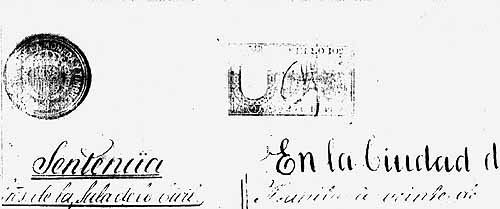
|

|
| During
the first seven days immediately after the occupation of Manila on August
13, 1898, U. S. Military Government was established to assume the functions
of government, which, prior to the fall of Manila, had been exercised by
the Spanish authorities. The administration of the Customs
and internal Revenue departments was taken over by the on August 20, 1898.
Captain C. F. Mudgett, an officer of the, U.S. Army was named Collector
of Internal Revenue. Two of his fellow officers, Lieutenants
C. S. Haughwout and C. H. Sleeper, were named Assistant to the Collector,
and Deputy Collector of Internal Revenue, respectively. These officials
took charge of the revenue stamps and stamped paper, which were found in
the warehouse of the defunct Spanish - Philippines Treasury Department.
It was felt that a surcharge of some sort should be affixed to the stamps and stamped paper before they were offered for sale, in order to indicate the change of sovereignty and to avoid any possible loss of revenue to the newly created U.S. Military Government from the use of any unused stocks of those revenue stamps and stamped paper which might have been in private hands at the time of the surrender of Manila. But no dies for this purpose was at hand and there was urgent need for the immediate release of the stamps and stamped paper. Hence, on August 20, 1898, the Collector of Internal Revenue, above mentioned, began, the issue of Spanish – Philippines revenue stamps and stamped paper surcharged with the initials of the Collector, himself, his Assistant, or the Deputy Collector. These Initials were written on the stamps and stamped paper by hand, usually in red ink. The initials affixed were; “C F M” by Captain. C. F. Mudgett, “C S H” by Lt. C. S. Haughwout and “C H S” by Lt. C. H. Sleeper. The initials of only one of these officials were affixed to each stamp. Revenue stamps and stamped paper bearing these handwritten initials remained in use until about the end of January 1899. [34] 
Figure 14 Figure 14 shows a specimen of Spanish-Philippine stamped paper of the biennial period of 1898-99, with the initial “C H S” written in red ink on the stamp, The document of which this sheet of stamped paper forms a part is a certified copy of a judicial decision rendered on October 20, 1898, by the Territorial Audiencia (Supreme Court) of Manila in an appeal from a decision of the Court of First Instance of La union instituted by the defendant in a civil Suit, This copy of the decision of the Territorial Audiencia was issued on November 16, 1898, and is certified and signed by the Secretary of the territorial Audiencia. It is interesting to note that at that time, three months after the occupation of Manila by the American forces, the Territorial Audiencia (Supreme Court) of Manila, which the U.S. Military Government inherited from the Spanish regime, was still functioning. The Judges of the Territorial Audiencia who rendered this decision were Don Joaquin Escudero y Tascon, Acting President, and Don Diego de los Monteres and Don Trinidad Jurado. Beginning in 1899, probably in February, rubber stamped surcharges was affixed to the existing Spanish - Philippines stamped paper prior to its use. These surcharges were applied, not only to the stamped paper of the current biennial period of 1898-99, but also to any obsolete stamped paper, which was available. The rubber-stamped surcharged of the U.S. Military Government known to have been applied to stamped paper of the biennial periods of 1894-95, 1896-97, and 1898-99. But it seems probable, since there is no evidence that any other stamped paper was used, that subsequent to July l, 1901, stamped paper bearing the surcharges of the U.S. Military Government was used until the end of 1904, not only in these portions of the Philippines which remained under the Jurisdiction of the U.S. Military Government. With one exception, all of the known surcharges were rubber - stamped. The surcharges which are known to have been applied to stamped are listed below:
|
|
|
|
|
|
|
|
|
|
|
|
|
|
|
|